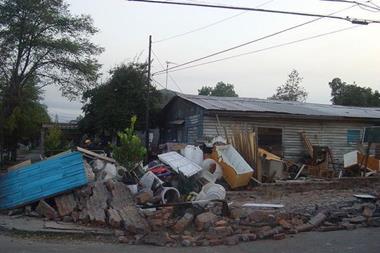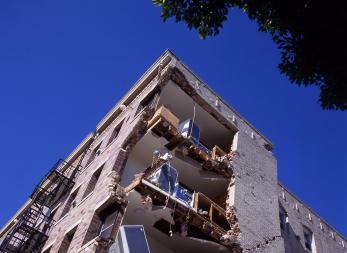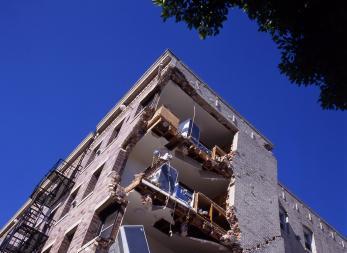Could we be on the brink of the next mega-quake? Six months on from Chile, when and where can we expect future earth-moving – and no doubt market-moving – events?
Undoubtedly, this year has already delivered a sharp reminder to insurers about the power wielded by natural hazards on the industry, as events in Chile and Haiti have shown once again the devastating impact of earthquakes.
According to the director of Aon Benfield UCL Hazard Research Centre (ABUHRC), Bill McGuire, more than 40 countries are currently under threat of serious destructive earthquakes. Over the last millennium, these lethal natural disasters have wreaked a death toll of eight million people, with two million of those deaths occurring in the last century. Between 1990 and 1999 alone, the cost of earthquakes was calculated at £140bn.
One of the major future threats is posed by the potential devastation wreaked by ‘mega-earthquakes’: seismic events that score eight or more on the moment magnitude (Mw) scale. Such earthquakes mostly occur at the earth’s subduction zones, where an oceanic plate slides beneath another plate, known as the upper plate, and the lower plate crashes down into the earth’s interior.
While forecasting such events remains notoriously tricky, ABUHRC has published a report outlining the places to watch. When the Earth Moves: Mega-earthquakes to come? pinpoints the hotspots for these potentially cataclysmic events and their financial implications.
Aon Benfield head of international analytics John Moore explains: “Predicting the location of the next mega-earthquake is an inexact science, but by examining the fault lines and historical precedence of earthquake activity in five of the world’s most vulnerable regions, this report sets out to assess the current risks and improve our understanding of where and when the next mega-earthquake could hit.”
The main regions identified in the report are subduction zones along Chile, Indonesia (Sumatra), Japan, North America (Cascadia) and the Caribbean (Lesser Antilles). The Chilean earthquake that struck in Maule on 27 February this year is the most recent example of a subduction earthquake and the seventh-largest magnitude earthquake ever recorded.
Nevertheless, this quake, which recorded at 8.8Mw, pales in comparison to the strength of previous subduction earthquakes in the region. The largest earthquake ever recorded occurred in Chile in 1960, hitting 9.5Mw.
Next big risk
Moreover, while Chile is still reeling from its most recent quake, it is likely the area could be primed for yet another disaster. In the report, ABUHRC’s Dr Simon Day points out that the North Chile segment of the Chile-Peru subduction zone is the only segment not to have ruptured in the last 100 years, putting the region at high risk of a mega-earthquake of 8.3Mw or more.
Meanwhile, the Maule earthquake has already resulted in a gross loss of $8bn reported by Chilean insurance companies, leading to reinsurance programmes in the region renewing with increases of 75% or more.
The report notes that the probability of a mega-earthquake erupting in Sumatra region in Indonesia in the near future is also a strong possibility. Historical mega-earthquakes have occurred in 1797, 1833, 2005 and 2007 in this zone, all leading to destructive tsunamis.
McGuire believes that the site of the 1797 quake, which lies directly offshore from Padang, is the next likely rupture in the region, leaving the city at severe risk from a tsunami caused from a mega-earthquake 8.5Mw or more.
Moore points out that the Padang earthquake of 2009, which reached 7.6Mw, has already hit many insurance companies, leading to increases of 5%-15% on their reinsurance programmes. If a mega-earthquake ruptures, the price of reinsurance cover, largely supplied by international insurers based in Singapore, is likely to rise substantially on the back of sizeable insured losses.
Peak perils
The region of huge concern is Japan. McGuire predicts that while a repeat of the great Kanto quake of 1923 is probably a century or more away, a smaller event directly beneath Tokyo is expected sooner. Indeed, he forecasts there is 29% chance of a 7.3Mw rupture beneath Tokyo occurring within the next 30 years.
While this would not qualify as a mega-earthquake, there would be enormous implications. Such an event would lead to an estimated 11,000 deaths, leave 210,000 people injured and destroy up to 840,000 buildings, according to a Japanese government risk assessment. It also states that the total losses resulting from such a scenario could reach £640bn.
Moreover, the South Japan subduction zone, also known as the Nankai Trough, has the longest historical record of ruptures in the world. The danger here is that a pair of segments can erupt along the zone or, in the worst-case scenario, the entire zone can rupture, breaking into a giant quake.
“Depending on the location, a mega-earthquake in this region would most likely be a market-moving event,” Moore notes. “For reinsurers, Chile has been an earnings issue while a similar event in Japan would also likely hit their capital, and most reinsurers see it as a peak peril.”
Then there is the risk posed to North America. At nearly 1,000km long, the Cascadia Subduction zone extends from Cape Mendocino in Northern California to central Vancouver in Canada. Day points out that research suggests that earthquakes in this subduction zone can be clustered into a series of up to five events over 1,500-2,000 years. There have been three earthquakes in this zone in the last 1,000 years, suggesting the area is in the middle of an earthquake series.
If the region holds true to this sequence, an earthquake will most likely rupture beneath the sea to the west of major cities Portland, Seattle and Vancouver, creating a major tsunami threat to coastal communities along the Pacific coast.
“While the short- to medium-term probability of such a Cascadia earthquake may be low – certainly in comparison to the situation in Sumatra – the detailed palaeoseismic investigations have clearly established the potential for such an event in the future,” Moore says, “and insurers should not disregard the associated risks to the cities of the Pacific Northwest region.”
Spotting hotspots
Meanwhile, the stage could also be set for the Caribbean to be hit by a major earthquake. The absence of historical earthquakes along a very large part of this subduction zone, scientists believe, can be used to infer the occurrence of rare but very large earthquakes.
Day believes the 2cm-a-year rate of plate convergence is enough to produce a 9Mw mega-earthquake every 3,000 years or so, meaning that the region could be due for a massive rupture. Consequently, the major loss would swiftly absorb available reinsurance and significantly harden rates. It is expected that price rises would pass quickly onto the primary market.
In addition to these hotpots, McGuire points out there have been no major earthquakes in the Himalayas in South Asia since 1700 and parts have not ruptured for 700 years. If an earthquake did strike once again in this region, it could lead to death tolls of between 200,000 to one million. In total, up to 50 million people along the Ganges are at risk from earthquakes.
While mega-earthquakes are an inevitability of the future, it is hoped that such pioneering research will go a long way towards guiding insurers and reinsurers underwriting risks in some of the world’s most earthquake prone areas.
As Moore puts it, the ultimate goal is to create “a more risk-aware world” in the face of these deadly – and extremely costly – natural hazards. IT
Hosted by comedian and actor Tom Allen, 34 Gold, 23 Silver and 22 Bronze awards were handed out across an amazing 34 categories recognising brilliance and innovation right across the breadth of UK general insurance.














































No comments yet